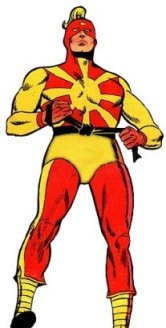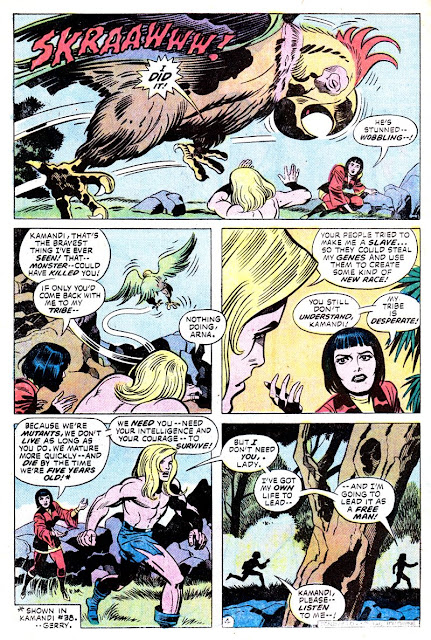I conclude my look at Jack Kirby's
Kamandi, The Last Boy on Earth with this final set of five issues. Two issues previously Gerry Conway had been installed as the editor of the series and Joe Kubert had taken over the chores as cover artist, two clear signs that Jack Kirby's time at DC was quickly coming to an end.

In this thirty-fifth issue of the series we find Kamandi along with his pal Doctor Canus returning to Earth with Pyra aboard her spacecraft. They find themselves in Mexico at what was once a resort hotel in Acapulco. But quickly Kamandi finds that the rules are starkly different in this brave new world. The pool is lorded over by Crocodiles who view Kamandi as vermin clogging up the pool. They turn him over to a Jaguar and Kamandi learns that the Jaguars are in charge of the resort which follows the simple but brutal rules of "The customer is always right." and "Survival of the fittest." as different species battle it out for control of different floors of the resort. Kamandi has a disdain for Wolves and lays claim to the second floor they occupy and uses a noxious glue to drive them out and when they jump in the pool a brutal battle with the Crocs ensues.

The next issue is the last written by Kirby and finds Kamandi leaving Canus and Pyra as he investigates a herd of humans who seem to be migrating to some unknown destination. They are being driven by music hidden in rocks (rock music...get it) and are compelled to to find its source.
Kamandi finds that vicious riders are actually rounding up these humans as they appear for reasons which are unknown. The Red Raiders turn out to be mutant humans, the result of genetic testing, who have a life span of only five years and are desperately searching for DNA which will reinvigorate them. Kamandi is introduced to a girl named Arna. Meanwhile Pyra and Canus are shot down.

Gerry Conway takes on the writing chores and Mike Royer returns to ink Kirby on what prove to be his last three issues of Kamandi. Kamandi is taken captive by the Crater People so that they may extract his DNA. Meanwhile Doctor Canus and Pyra pull themselves out of the wreckage of her spacecraft and Canus learns that Pyra is from a planet called Zirandius and her mission was to search the whole of space to find new energy sources for her people who had depleted theirs. She is attracted to the Earth by the Great Disaster explosion and has since been gathering up relics from the ruins of the planet. Kamandi discovers that the Crater People are an experiment to solve overpopulation by giving humans a tiny five-year lifespan and now Arna wants more from him. He escapes and Arna follows him knowing she will be killed if she is blamed for his loss. The Crater People go mad with rage and chase the pair out of their territory but the duo are attacked by a giant Lobster.

The Lobster takes Kamandi and Arna to a vast undersea "Airquarium" where the two are added to the ranks of many humans that the Lobster, a giant Snail, and a giant Clam operate as an experimental station. We get a glimpse of what has been happening with Tuftan and Ben Boxer when we see the great sea battle they waged against the Apes is won but Boxer is held captive by Tuftan for his treasonous act during the battle when he freed a prisoner.
Kamandi rejects being the subject of an experiment and organizes the humans to work together to break out of their undersea prison. A human named Smasher holds the Lobsters at bay while the humans and Kamandi and Arna escape. Sadly his sacrifice is not understood or appreciated by his fellow humans who wander off into the wildnerness.
In the final Kirby-drawn issue of
Kamandi we find Kamandi and Arna assaulted by a giant Parrot in what was once Mexico. The fend it off but the scene shifts to Doctor Canus and Pyra who have been taken captive by Lizards.
They learn that the Lizards rely on heat to keep active and with the summer sun leaving they need the heat supplied by an unknown source on a distant mountaintop. The Lizards employ Donkeys as slaves which angers Pyra. Meanwhile Kamandi and Arna are tricked by Donkeys and captured and taken to the city of the Lizards. Kamandi is given the mission to go up the mountain and bring back the heat source. He does but discovers it is a nuclear reactor and when it is brought to the town it destabilizes and explodes. Kamandi, Arna, and Doctor Canus escape and wander into the wildnerness to their next adventure, the fate of Pyra is unknown.
And that's it.
Kamandi will go on when Dick Ayers is brought aboard to do the pencil art chores. Kirby completes his obligations to DC and will make his return to Marvel.
Jack Kirby's run on
Kamandi, The Last Boy on Earth was arguably his most successful during his third run at DC Comics, lasting over three times longer than nearly every one of his other efforts. The man who had helped create the
Newsboy Legion, the Boy Commandos, and revamped
Sandman and
Manhunter with his partner Joe Simon was one of the talents who had made the company great in the war years. A decade later in the Cold War era he returned and gave birth to the
Challengers of the Unknown. This third go at the company had begun with huge anticipation as the venerable company experienced its first really major shake up since the birth of the genre. Thanks to Kirby's work in tandem with Stan Lee, DC lost its place as the leader in the field (though technically that would not happen in terms of sales until after Kirby was already at DC). The dramatic replacement of longtime writers and editors with a thrust toward using artists to fill the gaps and point the way forward was a departure and a gamble which looms large in retrospect and was seen as such at the time.
But it was over by the time the fortieth issue of
Kamandi hit the stands in 1976 and with it both Kirby and Infantino, the man who brought him over would be gone from DC. Kirby would return to Marvel with great fanfare, though there too he would meet weirdly a great deal of disrespect. Ironically Infantino himself would venture over to Marvel where he worked on several series as an artist during the late Bronze Age. DC would look for new ways to sell comics, experimenting with Dollar Books and other formats. Kamndi would go on, but it was just one more book among many without the distinctive hand of the King of Comics to guide it.
No more to come.
Rip Off


























































